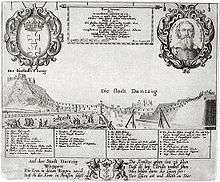Adam Wybe
Adam Wybe, also known as Adams Wiebe (born July 12th, 1584[1][2] in Harlingen, Friesland, died in 1653 in Gdańsk), was an engineer and inventor of Dutch origin, active mainly in Gdańsk. His work includes the world's first cable car on multiple supports in 1644. It was the biggest built till the end of 19th century.[3]
He lived in Gdańsk since ca. 1616. He became famous for many inventions and constructions: a horse-driven dredger, river ice cutter, and an acqueduct taking Radunia River waters over the moat in the Hucisko crossroads area.[4] The construction in 1644 of rope railway was his most famous realization. Admittedly, during previous centuries there were already ropeways which resembled cable cars in existence, but Wybe changed and improved it as follows: It is the first to use industrially, a cable (instead of a rope) in loop and continuous motion, and the first to multiply the 'vehicles'. It improved it by supporting the cable by pylons equipped with pulleys, and unloaded of the basket 'vehicles' by means of a swing. The machine was longer than 200 meters. It includes 7 wooden pylons, and seems to carry a score about 120 'vehicles'.[5]
Biography

Outside of the village of origin - Harlingen in Friesland - no details are known of his youth, there is also no record on his parents. His wife's name was Margarethe.[1]
References
- 1 2 Deutsches Geschlechterbuch, Band 132. p. 204.
- ↑ Dueck, Ulrich (1986). die Familie Rahn von Tiegenhof.
- ↑ "WIEBE ADAM – Encyklopedia Gdańska" (in Polish). Encyklopediagdanska.pl. Retrieved 2014-04-20.
- ↑ "Archived copy". Archived from the original on 2005-02-10. Retrieved 2015-07-31.
- ↑ http://www.skistory.com/F/transports/C24.html Le transporteur d'Adam Wybe à Dantzig